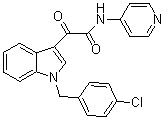Indibulin is a synthetic small molecule with antimitotic and potential antineoplastic activities. Indibulin destabilizes tubulin polymerization and induces tumor cell cycle arrest and apoptosis by binding to a site on tubulin that is distinct from taxane- or Vinca alkaloid-binding sites. It has been demonstrated that this substance is effective against tumor cell lines that are taxane- and multidrug-resistant (MDR). Use this agent to look up any closed or ongoing clinical trials. (Thesaurus NCI).
Physicochemical Properties
| Molecular Formula | C22H16CLN3O2 |
| Molecular Weight | 389.83 |
| Exact Mass | 389.093 |
| Elemental Analysis | C, 67.78; H, 4.14; Cl, 9.09; N, 10.78; O, 8.21 |
| CAS # | 204205-90-3 |
| Related CAS # | 204205-90-3 |
| PubChem CID | 2929 |
| Appearance | Off-white to yellow solid powder |
| Density | 1.3±0.1 g/cm3 |
| Index of Refraction | 1.665 |
| LogP | 4.5 |
| Hydrogen Bond Donor Count | 1 |
| Hydrogen Bond Acceptor Count | 3 |
| Rotatable Bond Count | 5 |
| Heavy Atom Count | 28 |
| Complexity | 558 |
| Defined Atom Stereocenter Count | 0 |
| SMILES | C1=CC=C2C(=C1)C(=CN2CC3=CC=C(C=C3)Cl)C(=O)C(=O)N=C4C=CNC=C4 |
| InChi Key | SOLIIYNRSAWTSQ-UHFFFAOYSA-N |
| InChi Code | InChI=1S/C22H16ClN3O2/c23-16-7-5-15(6-8-16)13-26-14-19(18-3-1-2-4-20(18)26)21(27)22(28)25-17-9-11-24-12-10-17/h1-12,14H,13H2,(H,24,25,28) |
| Chemical Name | 2-[1-[(4-chlorophenyl)methyl]indol-3-yl]-2-oxo-N-pyridin-4-ylacetamide |
| Synonyms | ZIO-301; ZINC01996564; ZERO/005632; D-24851; d-24851; NCGC00160428-01 |
| HS Tariff Code | 2934.99.9001 |
| Storage |
Powder-20°C 3 years 4°C 2 years In solvent -80°C 6 months -20°C 1 month |
| Shipping Condition | Room temperature (This product is stable at ambient temperature for a few days during ordinary shipping and time spent in Customs) |
Biological Activity
| Targets | Tubulin |
| ln Vitro |
Indibulin (300-2100 nM; 48 hours) has an IC50 of 150 nM, which inhibits the growth of MCF-7 cells. Indibulin (300, 600 nM; 48 hours) inhibits G2/M phase cells, suggesting that it prevents the cell cycle from progressing during mitosis[1]. Indibulin (150-600 nM; 24 hours) causes MCF-7 cells to undergo apoptosis[1]. When Indibulin (150-600 nM; 48 hours) at concentrations of 300 and 600 nM is used to treat MCF-7 cells, it produces cleaved fragments of the PARP protein[1]. |
| Cell Assay |
Cell Line: MCF-7 cells Concentration: 300, 600, 900, 1200, 1500, 1800, 2100 nM Incubation Time: 48 hours Result: Inhibited the proliferation of MCF-7 cells with an IC50 of 150 nM. |
| References |
[1]. Indibulin dampens microtubule dynamics and produces synergistic antiproliferative effect with vinblastine in MCF-7 cells: Implications in cancer chemotherapy. Sci Rep. 2018 Aug 17;8(1):12363. |
| Additional Infomation |
Indibulin is a synthetic small molecule with antimitotic and potential antineoplastic activities. Indibulin binds to a site on tubulin that is different from taxane- or Vinca alkaloid-binding sites, destabilizing tubulin polymerization and inducing tumor cell cycle arrest and apoptosis. This agent has been shown to be active against multidrug-resistant (MDR) and taxane- resistant tumor cell lines. Drug Indication Investigated for use/treatment in solid tumors. |
Solubility Data
| Solubility (In Vitro) | DMSO: 40~50 mg/mL (102.6~128.3 mM) |
| Solubility (In Vivo) |
Solubility in Formulation 1: 2.08 mg/mL (5.34 mM) in 10% DMSO + 90% (20% SBE-β-CD in Saline) (add these co-solvents sequentially from left to right, and one by one), suspension solution; with sonication. For example, if 1 mL of working solution is to be prepared, you can add 100 μL of 20.8 mg/mL clear DMSO stock solution to 900 μL of 20% SBE-β-CD physiological saline solution and mix evenly. Preparation of 20% SBE-β-CD in Saline (4°C,1 week): Dissolve 2 g SBE-β-CD in 10 mL saline to obtain a clear solution. Solubility in Formulation 2: ≥ 2.08 mg/mL (5.34 mM) (saturation unknown) in 10% DMSO + 90% Corn Oil (add these co-solvents sequentially from left to right, and one by one), clear solution. For example, if 1 mL of working solution is to be prepared, you can add 100 μL of 20.8 mg/mL clear DMSO stock solution to 900 μL of corn oil and mix evenly. (Please use freshly prepared in vivo formulations for optimal results.) |
| Preparing Stock Solutions | 1 mg | 5 mg | 10 mg | |
| 1 mM | 2.5652 mL | 12.8261 mL | 25.6522 mL | |
| 5 mM | 0.5130 mL | 2.5652 mL | 5.1304 mL | |
| 10 mM | 0.2565 mL | 1.2826 mL | 2.5652 mL |
